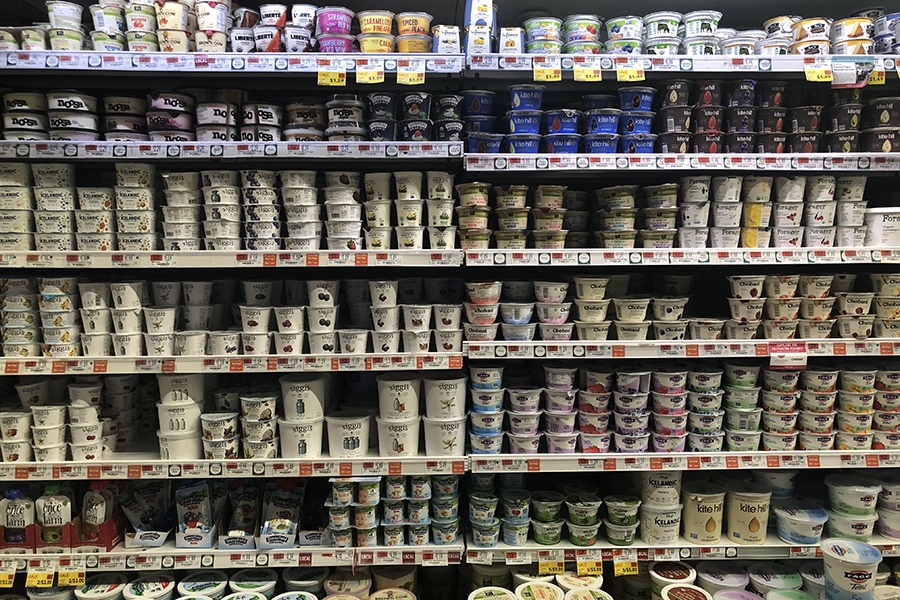Ask the Expert: Which Yogurt Is the Healthiest?
The options in the dairy aisle are endless.

Photo by Rachel Kashdan
Have you ever stood in the refrigerator aisle of the grocery store, between the milk and the eggs, staring at the wall of yogurts completely perplexed? We certainly have. The options to fulfill your dairy needs truly are endless. While many of us think of yogurt as a healthy snack, with supermarket options offering everything from strawberry puree mix in to key lime pie, actually figuring out which one is best for your health can be a challenge. And sometimes what can be touted as a health food is actually just full of processed sugar and preservatives. To help us decipher what yogurt you should actually be snacking on, we asked Arlington-based registered dietitian Elissa Goldman for her recommendation. And chances are, you probably already know the answer.
Ask the Expert: Which Yogurt Is the Healthiest?
The answer: Plain Greek yogurt.
The details:
“The healthiest” is an arbitrary term in the nutrition world. What is “the healthiest” to one person might not be the best for another person, but when it comes to general recommendations some food choices are deemed healthier for many different reasons. When it comes to yogurt, your best bet is to reach for something low in added sugar and with the smallest ingredient list. “I advise my clients to go with plain Greek yogurt and then add in their desired fix-ins to make it sweeter and more palatable,” Goldman says. Her favorite fix-ins are peanut butter, fruit preserves, and a handful of walnuts. By adding your own fix-ins you control how much you are eating and where your food is coming from.
In a typical serving (200g) of plain Greek yogurt (the Fage 2% brand to be exact), you’re getting 20g of protein, 4g of fat, and only 6g of sugar—topping out at just 140 calories. The ingredient list is short: Pasteurized skim milk, active yogurt cultures, and cream. And it goes through a straining process to remove the whey from the milk, which is why you’re getting way more protein per serving, compared to regular yogurts. Because most of the whey is removed, it also makes a great dairy choice for those who are sensitive to lactose.
“Eating yogurt is a great way to get calcium, vitamin D, potassium, and live cultures into your diet,” Goldman explains. Live cultures refer to the living organisms Lactobacillus Bulgaricus and Streptococcus Thermophilus that convert milk to yogurt during fermentation. These are also responsible for promoting a healthy and balanced gut by increasing the good bacteria stored there. Goldman says to make sure the container of the yogurt you are choosing says “contains active cultures” or “live cultures.”
If you’re not a fan of that particularly strong, tangy taste plain Greek yogurt has, you might be more fond of the Icelandic version called Skyr from brands like Siggis and Icelandic Provisions—it has a generally sweeter and creamier taste. Just like Greek yogurt, it’s thicker and more concentrated than other yogurts, but where it deviates is in the cultures that are used. Skyr is made much like sourdough, in that the cultures have been preserved and passed down through generations of families in Iceland for centuries. If you were to make Skyr on your own, you would have to buy store-bought Skyr and mix it with milk.
It’s also worth mentioning that the previously held belief that fat-free and low-fat dairy was the way to go is no longer supported by recent research. According to a study conducted by the Harvard School of Public Health, full-fat dairy products like milk, cheese, and yogurt were not linked to an increase in heart disease. Plus, full-fat yogurt like Noosa or Wallaby almost taste like ice cream, and we’re totally here for that. But, if you are looking to cut back on calories, low-fat or fat-free might still be your best option.
And plain Greek yogurt doesn’t just have to be limited to consumption with a spoon. Goldman says it can be used in dips—like the one for these sweet potato fritters—or in breakfast smoothies for added protein and flavor. It can also be used in baked goods like cakes, pancakes, and bagels and even in salad dressings, or in place of sour cream for your tacos.
Bottom line, which ever way you dole it out, plain Greek yogurt is the best bang for your buck in terms of nutrients and calories. Plus, when it comes to toppings your options are even more endless than those in the yogurt aisle.

